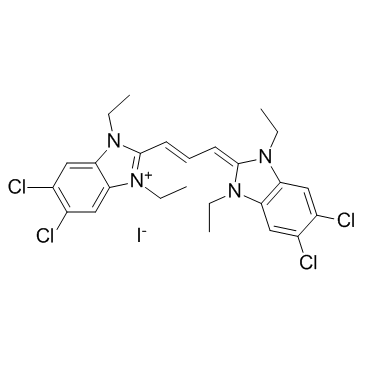CBIC2

CBIC2结构式

|
常用名 | CBIC2 | 英文名 | JC-1 |
|---|---|---|---|---|
| CAS号 | 3520-43-2 | 分子量 | 652.225 | |
| 密度 | N/A | 沸点 | N/A | |
| 分子式 | C25H27Cl4IN4 | 熔点 | N/A | |
| MSDS | 中文版 美版 | 闪点 | N/A |
|
Omega-3 fatty acids, EPA and DHA induce apoptosis and enhance drug sensitivity in multiple myeloma cells but not in normal peripheral mononuclear cells.
J. Nutr. Biochem. 25(12) , 1254-62, (2014) The n-3 polyunsaturated fatty acids eicosapentaenoic acid (EPA) and docosahexaenoic acid (DHA) have been shown to enhance the effect of chemotherapeutic drugs in clinical studies in cancer patients and to induce apoptotic tumor cell death in vitro. Until now,... |
|
|
Mitochondrial targeting of bilirubin regulatory enzymes: An adaptive response to oxidative stress.
Toxicol. Appl. Pharmacol. 282(1) , 77-89, (2015) The intracellular level of bilirubin (BR), an endogenous antioxidant that is cytotoxic at high concentrations, is tightly controlled within the optimal therapeutic range. We have recently described a concerted intracellular BR regulation by two microsomal enz... |
|
|
DOCK8 regulates lymphocyte shape integrity for skin antiviral immunity.
J. Exp. Med. 211(13) , 2549-66, (2014) DOCK8 mutations result in an inherited combined immunodeficiency characterized by increased susceptibility to skin and other infections. We show that when DOCK8-deficient T and NK cells migrate through confined spaces, they develop cell shape and nuclear defo... |
|
|
Apoptotic and neurotoxic actions of 4-para-nonylphenol are accompanied by activation of retinoid X receptor and impairment of classical estrogen receptor signaling
J. Steroid Biochem. Mol. Biol. 144 Pt B , 334-47, (2014) • Age-dependent action of nonylphenol (NP) on mouse neuronal cells was demonstrated. • Estrogen receptor (ER) antagonists potentiated the NP-induced apoptosis and toxicity. • ER agonists inhibited the NP-evoked effects in mouse hippocampal cells. • The retino... |
|
|
Superparamagnetic iron oxide nanoparticles exacerbate the risks of reactive oxygen species-mediated external stresses.
Arch. Toxicol. 89(3) , 357-69, (2015) Superparamagnetic iron oxide nanoparticles (IONPs) have been widely applied in numerous biomedical fields. The evaluation of the toxicity of IONPs to the environment and human beings is indispensable to guide their applications. IONPs are usually considered t... |
|
|
Interferon-gamma induced cell death: Regulation and contributions of nitric oxide, cJun N-terminal kinase, reactive oxygen species and peroxynitrite.
Biochim. Biophys. Acta 1843(11) , 2645-61, (2014) Interferon-gamma (Ifnγ), a known immunomodulatory cytokine, regulates cell proliferation and survival. In this study, the mechanisms leading to the selective susceptibility of some tumor cells to Ifnγ were deciphered. Seven different mouse tumor cell lines te... |
|
|
Mitochondrial Optic Atrophy (OPA) 1 Processing Is Altered in Response to Neonatal Hypoxic-Ischemic Brain Injury.
Int. J. Mol. Sci. 16 , 22509-26, (2015) Perturbation of mitochondrial function and subsequent induction of cell death pathways are key hallmarks in neonatal hypoxic-ischemic (HI) injury, both in animal models and in term infants. Mitoprotective therapies therefore offer a new avenue for interventio... |
|
|
The antitumor compound triazoloacridinone C-1305 inhibits FLT3 kinase activity and potentiates apoptosis in mutant FLT3-ITD leukemia cells.
Acta Pharmacol. Sin. 36(3) , 385-99, (2015) FMS-like receptor tyrosine kinase (FLT3) is expressed in some normal hematopoietic cell types and plays an important role in the pathogenesis of acute myeloid leukemia (AML). In this study, we examined the effects of triazoloacridinone C-1305, an antitumor co... |
|
|
Transition metals activate TFEB in overexpressing cells.
Biochem. J. 470 , 65-76, (2015) Transition metal toxicity is an important factor in the pathogenesis of numerous human disorders, including neurodegenerative diseases. Lysosomes have emerged as important factors in transition metal toxicity because they handle transition metals via endocyto... |
|
|
Sodium Fluoride Induces Apoptosis in H9c2 Cardiomyocytes by Altering Mitochondrial Membrane Potential and Intracellular ROS Level.
Biol. Trace Elem. Res. 166 , 210-5, (2015) Chronic excessive fluoride intake is known to be toxic, and effects of long-term fluorosis on different organ systems have been examined. However, there are few studies about the effects of fluorosis on cardiovascular systems. Here, we studied the fluoride-in... |